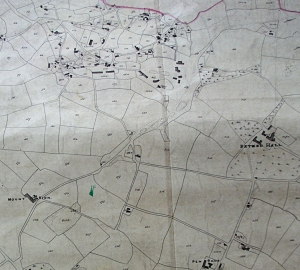You are currently browsing the monthly archive for October 2012.

From the Brymbo tithe map of around 1840. Although several roads are shown, they would have been very poor by today’s standards.
It’s very easy to take for granted exactly how simple it is to get from place to place in the present day. This is not only due to the invention of railways, and then cars, and finally of ways of bringing cars within the reach of more people, but also the immense improvement in the highway system. It’s difficult to appreciate the problems involved in travel before the development of modern roads: not just major highways, but even the firmly metalled country lanes of today’s landscape, are far in advance of what we were faced with a century and more ago.
As Brymbo’s tithe map shows, there were plenty of roads, lanes and trackways around in even the early 19th century. However, many of them did no more than connect isolated farms – as they had presumably always done since the farms first appeared. Even though the coal industry had come to the area many years before, these would have been lanes little better than a present-day footpath or bridleway. Travelling any distance would always have been a problem, especially in winter, and particularly if you had goods to transport. If you could fit your goods on a horse or donkey, or just on your shoulders, you might manage, but the unpleasantness and tedium of attempting to handle a cart over such lanes can only be imagined. Unsurfaced and filled with stones, deep ruts, and puddles, they often turned into a boggy morass into which pack animals and men were occasionally said to disappear completely. Though even in the 17th century, Brymbo coal had gone to Llanarmon and beyond, livestock to the markets and the droves through Bwlchwyn, and lime from Bwlchgwyn and Hope Mountain to local farmland, most of it would have travelled slowly.
